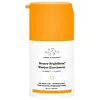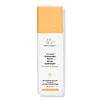What's inside
What's inside
 Key Ingredients
Key Ingredients

 Benefits
Benefits

 Concerns
Concerns

 Ingredients Side-by-side
Ingredients Side-by-side

Water
Skin ConditioningAzelaic Acid 10%
BufferingHydroxyethyl Acrylate/Sodium Acryloyldimethyl Taurate Copolymer
Emulsion StabilisingSalicylic Acid 1%
MaskingGlycerin
HumectantCucurbita Pepo Seed Oil
EmollientSalvia Hispanica Seed Oil
MoisturisingSclerocarya Birrea Seed Oil
HumectantPentylene Glycol
Skin ConditioningDiglucosyl Gallic Acid
Niacinamide
SmoothingPhloretin
AntioxidantAllantoin
Skin ConditioningFerulic Acid
AntimicrobialDipotassium Glycyrrhizate
HumectantTremella Fuciformis Sporocarp Extract
AntioxidantBehenic Acid
CleansingGlutathione
Linoleic Acid
CleansingTocotrienols
Skin ConditioningThioctic Acid
AntioxidantLinolenic Acid
CleansingErgothioneine
AntioxidantCholesterol
EmollientCeramide Ns
Skin ConditioningCeramide AP
Skin ConditioningCeramide EOP
Skin ConditioningCeramide Eos
Skin ConditioningCeramide NP
Skin ConditioningSodium Hyaluronate Crosspolymer
HumectantAmylopectin
Ellagic Acid
Skin ConditioningPseudozyma Epicola/Camellia Sinensis Seed Oil Ferment Extract Filtrate
HumectantCaprooyl Phytosphingosine
Skin ConditioningCaprooyl Sphingosine
Skin ConditioningSqualane
EmollientAscorbyl Palmitate
AntioxidantAcetyl Glucosamine
Skin ConditioningPunica Granatum Extract
AstringentDextrin
AbsorbentSebacic Acid
BufferingOryza Sativa Bran Oil
EmollientTocopherol
AntioxidantCeteareth-25
CleansingPhenoxyethanol
PreservativeSorbitan Isostearate
EmulsifyingPolydextrose
HumectantCetyl Alcohol
EmollientCaprylyl Glycol
EmollientChlorphenesin
AntimicrobialPolysorbate 60
EmulsifyingEthylhexylglycerin
Skin ConditioningWater, Azelaic Acid 10%, Hydroxyethyl Acrylate/Sodium Acryloyldimethyl Taurate Copolymer, Salicylic Acid 1%, Glycerin, Cucurbita Pepo Seed Oil, Salvia Hispanica Seed Oil, Sclerocarya Birrea Seed Oil, Pentylene Glycol, Diglucosyl Gallic Acid, Niacinamide, Phloretin, Allantoin, Ferulic Acid, Dipotassium Glycyrrhizate, Tremella Fuciformis Sporocarp Extract, Behenic Acid, Glutathione, Linoleic Acid, Tocotrienols, Thioctic Acid, Linolenic Acid, Ergothioneine, Cholesterol, Ceramide Ns, Ceramide AP, Ceramide EOP, Ceramide Eos, Ceramide NP, Sodium Hyaluronate Crosspolymer, Amylopectin, Ellagic Acid, Pseudozyma Epicola/Camellia Sinensis Seed Oil Ferment Extract Filtrate, Caprooyl Phytosphingosine, Caprooyl Sphingosine, Squalane, Ascorbyl Palmitate, Acetyl Glucosamine, Punica Granatum Extract, Dextrin, Sebacic Acid, Oryza Sativa Bran Oil, Tocopherol, Ceteareth-25, Phenoxyethanol, Sorbitan Isostearate, Polydextrose, Cetyl Alcohol, Caprylyl Glycol, Chlorphenesin, Polysorbate 60, Ethylhexylglycerin
Water
Skin ConditioningPropanediol
SolventSodium Ascorbyl Phosphate
AntioxidantGlycerin
HumectantIsodecyl Neopentanoate
EmollientSqualane
EmollientNeopentyl Glycol Diheptanoate
EmollientC9-12 Alkane
SolventSodium Polyacryloyldimethyl Taurate
Emulsion StabilisingAscorbyl Glucoside
AntioxidantCoco-Caprylate/Caprate
EmollientSclerocarya Birrea Seed Oil
HumectantPullulan
Sclerotium Gum
Emulsion StabilisingDiglucosyl Gallic Acid
Sorbitan Sesquiisostearate
EmulsifyingGlutathione
Sodium Hyaluronate
HumectantSorbeth-30 Tetraisostearate
EmulsifyingDipropylene Glycol
HumectantPhloretin
AntioxidantSodium Citrate
BufferingSodium Metabisulfite
AntioxidantPPG-8-Ceteth-20
EmulsifyingGluconolactone
Skin ConditioningAcrylates/Beheneth-25 Methacrylate Copolymer
Citric Acid
BufferingTetrasodium Glutamate Diacetate
Silica
AbrasiveLecithin
EmollientXanthan Gum
EmulsifyingTocopheryl Acetate
AntioxidantSodium Hydroxide
BufferingPhenoxyethanol
PreservativeSodium Benzoate
MaskingChondrus Crispus Extract
Skin ConditioningWater, Propanediol, Sodium Ascorbyl Phosphate, Glycerin, Isodecyl Neopentanoate, Squalane, Neopentyl Glycol Diheptanoate, C9-12 Alkane, Sodium Polyacryloyldimethyl Taurate, Ascorbyl Glucoside, Coco-Caprylate/Caprate, Sclerocarya Birrea Seed Oil, Pullulan, Sclerotium Gum, Diglucosyl Gallic Acid, Sorbitan Sesquiisostearate, Glutathione, Sodium Hyaluronate, Sorbeth-30 Tetraisostearate, Dipropylene Glycol, Phloretin, Sodium Citrate, Sodium Metabisulfite, PPG-8-Ceteth-20, Gluconolactone, Acrylates/Beheneth-25 Methacrylate Copolymer, Citric Acid, Tetrasodium Glutamate Diacetate, Silica, Lecithin, Xanthan Gum, Tocopheryl Acetate, Sodium Hydroxide, Phenoxyethanol, Sodium Benzoate, Chondrus Crispus Extract
 Reviews
Reviews

Alternatives
Ingredients Explained
These ingredients are found in both products.
Ingredients higher up in an ingredient list are typically present in a larger amount.
We don't have a description for Diglucosyl Gallic Acid yet.
Glutathione is an antioxidant naturally found in our bodies. It is made up of three amino acids: glycine, cysteine, and glutamic acid.
As an antioxidant, it prevents oxidative damage to parts of our cell.
While glutathione is said to help with fading dark spots, the results from research are inconclusive. Further studies are needed. With that said, gluthatione has been shown to protect our skin from UV-B induced damage.
This ingredient is naturally occurring in plants, animals, fungi, and some bacteria.
Learn more about GlutathioneGlycerin is already naturally found in your skin. It helps moisturize and protect your skin.
A study from 2016 found glycerin to be more effective as a humectant than AHAs and hyaluronic acid.
As a humectant, it helps the skin stay hydrated by pulling moisture to your skin. The low molecular weight of glycerin allows it to pull moisture into the deeper layers of your skin.
Hydrated skin improves your skin barrier; Your skin barrier helps protect against irritants and bacteria.
Glycerin has also been found to have antimicrobial and antiviral properties. Due to these properties, glycerin is often used in wound and burn treatments.
In cosmetics, glycerin is usually derived from plants such as soybean or palm. However, it can also be sourced from animals, such as tallow or animal fat.
This ingredient is organic, colorless, odorless, and non-toxic.
Glycerin is the name for this ingredient in American English. British English uses Glycerol/Glycerine.
Learn more about GlycerinPhenoxyethanol is a preservative that has germicide, antimicrobial, and aromatic properties. Studies show that phenoxyethanol can prevent microbial growth. By itself, it has a scent that is similar to that of a rose.
It's often used in formulations along with Caprylyl Glycol to preserve the shelf life of products.
Phloretin is a potent antioxidant. It can be naturally found in the leaves of apple trees and Manchurian apricots.
Sclerocarya Birrea Seed Oil is the oil expressed from the seeds of the Marula plant. In South Africa, Marula is called "an elephant's favorite treat".
Marula seed oil is a non-fragrant oil. It is rich in fatty acids, such as oleic, linoleic, palmitic, stearic, and more. These fatty acids help hydrate the skin.
Other components of marula seed oil include vitamin E and antioxidants such as flavonoids.
Due to the fatty acid content, this ingredient may not be fungal-acne safe.
Learn more about Sclerocarya Birrea Seed OilSqualane is an emollient that helps the skin hold onto moisture. It's an oily liquid that occurs naturally in certain types of fish and plant oils.
Because squalane boosts hydration in the skin, it also comes with plenty of benefits: it is an antioxidant and can help fight free radicals and skin damage. Squalane is also found to have a detoxifying effect when applied.
Squalane comes from squalene, which occurs naturally within the sebum of our skin. It is one of the oils our skin produces to keep itself hydrated. Squalane is the hydrogenated version of squalene and has a longer shelf life.
Research shows that squalane is non-irritating (even at 100% concentration).
In general, it's a fantastic ingredient. It does a great job at hydrating the skin, and it's suitable for those with sensitive skin.
The source of squalane may impact malassezia / fungal acne. This is because olive oil derived squalane can contain impurities such as fatty acids and plant waxes. Sugarcane derived squalane is recommended for anyone with malassezia concerns.
Is squalane vegan?
This depends on the source. Squalane can be derived from both plants and animals. Most squalane used in skincare comes from plants.
Please note: the source of squalane is only known if disclosed by the brand. We recommend reaching out to the brand if you have any questions about their squalane.
Read more about squalene with an "e".
Is squalane an oil?
Squalane is often called an oil, but it’s technically not; it’s a hydrocarbon, meaning it’s only made of carbon and hydrogen, unlike true oils which are triglycerides made of fatty acids and glycerol.
The term “oil-free” isn’t regulated, so companies can define it however they want. Some exclude all oils, while others just avoid mineral oil or comedogenic oils.
While some people avoid oils thinking they cause breakouts, the right kind of oil (or oil-like ingredient like squalane) can actually help balance and hydrate your skin. It’s worth testing out simple oils or squalane to see what works best for your skin.
Learn more about SqualaneWater. It's the most common cosmetic ingredient of all. You'll usually see it at the top of ingredient lists, meaning that it makes up the largest part of the product.
So why is it so popular? Water most often acts as a solvent - this means that it helps dissolve other ingredients into the formulation.
You'll also recognize water as that liquid we all need to stay alive. If you see this, drink a glass of water. Stay hydrated!
Learn more about Water